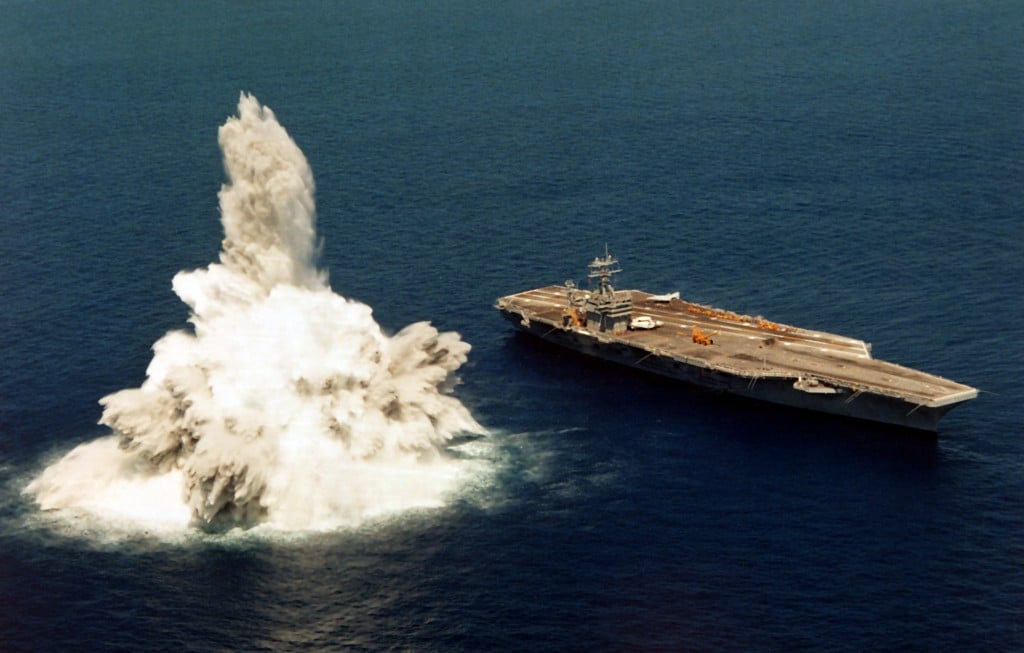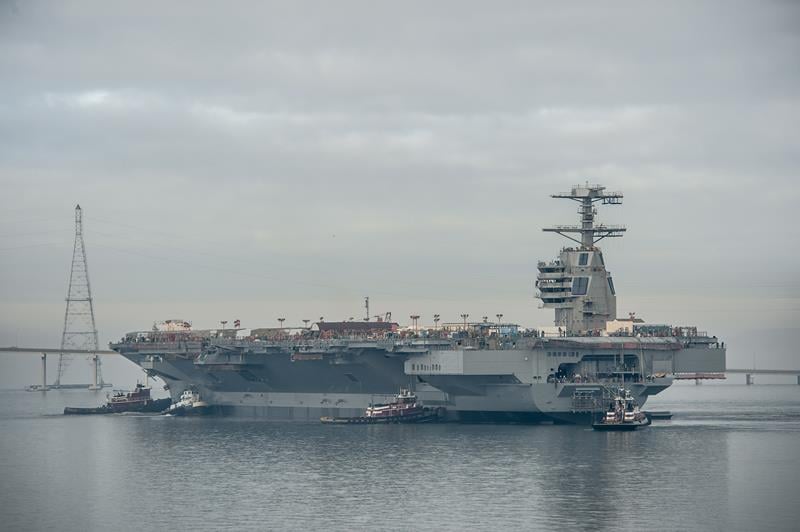Top Tester Tells Navy To Test Carrier, Destroyer Defenses With Real Missiles & Explosions
Posted on

A US Navy carrier, the USS Roosevelt, undergoing “full-ship shock trials” using live explosives.
You’d expect the nation’s top weapons tester to be a stickler about testing. But there’s “rigorous testing” and then there’s “let’s shoot cruise missiles at you and see what happens.”
It’s not that the Navy is wimpy about testing. The service conducts “full-ship shock trials” like the USS Roosevelt test pictured above, where it sets off a huge explosion next to a ship with a test crew aboard, as in this video of the destroyer USS Winston Churchill:
The Pentagon’s famously tough Director of Operational Test and Evaluation wants to Navy to speed up such shock testing on its new aircraft carrier, the cutting-edge and high-cost USS Gerald Ford. (More on that below). But a shock trial tests the ship’s structural strength, not its ability to shoot down incoming anti-ship missiles moving at hundreds or even thousands of miles per hour.
Even DOT&E doesn’t want the Navy to shoot live missiles directly at ships with live people on them: They want the Navy to build a new “unmanned test ship” and fire the missiles at that. Before the Navy can really say its latest self-defense systems are ready for prime time, DOT&E argues in its latest annual report (click here for full coverage), the military needs to test them under the most realistic conditions: at sea, installed on a real ship, with real missiles inbound. You just have no real sailors onboard in case the defenses don’t quite work as planned.
At issue is the new version of the Navy’s workhorse destroyer, the DDG-51 Arleigh Burke class, whose Aegis system is designed to detect and destroy incoming enemy aircraft and missiles before they can hit any part of the US fleet. According to DOT&E, the Navy’s current testing set-up can’t provide a real workout for the major upgrade intended for the new “Flight III” version of the Aegis destroyer, which will be the centerpiece of the fleet’s air and missile defenses for decades to come.
This has been an issue between DOT&E and the Navy for a while. Last year, DOT&E not only formally warned of “severe shortfalls” in the testing strategy but refused to approve two different Navy test plans.
“We cannot afford to not test future DDG-51 combat systems and radars under stressing conditions,” said a senior defense official (emphasis mine). “An unmanned Self-Defense Test Ship (SDTS) is therefore essential for an adequate operational test. Previous testing using the existing SDTS equipped with the combat systems used on aircraft carriers and amphibious assault ships has revealed that without the use of an SDTS, critical problems in defending against certain proliferating and dangerous threats would not have been found.”
The Navy does already have a “Self-Defense Test Ship” (SDTS), the former destroyer USS Foster — what one article called “the world’s biggest remote control ship” — on which it installs various self-defense equipment on and then shoots at to see if they work. (A human crew takes the Foster out to the designated test area, but they get off and run it by remote control before the shooting starts). Just last year, for example, the Foster was fitted with the latest version of the Navy’s Rolling Airframe Missile (RAM), a last-line-of-defense weapon to shoot down enemy missiles on the final approach, and conducted a successful test.
DOT&E’s problem is that the Foster isn’t set up to carry the much larger and more complex array of self-defense systems that will go on the Flight III Arleigh Burkes. And you can’t test them one component at a time because the hard part is getting them all to work together. The Flight III design replaces the heart of the Aegis defense system, the SPY-1 radar that first entered service in 1981, with an all-new Raytheon Air & Missile Defense Radar (AMDR) using the latest “active phased array” technology to greatly enhance performance — in theory.
The actual performance is what DOT&E wants to test, which by their analysis requires at least installing a whole AMDR on the Foster and more likely building an entirely new test ship, “an unmanned SDTS equipped with an AMDR and the DDG 51 Flight III Combat System.”
“The cost of building and operating an Aegis SDTS is small when compared to the total cost of the AMDR development/ procurement and the eventual cost of the 22 (plus) DDG 51 Flight III ships that are planned for acquisition ($55+ Billion),” says this week’s DOT&E report. “Even smaller is the cost of the SDTS compared to the cost of the ships that the DDG 51 Flight III Destroyer is expected to protect (~$450 Billion in new ship construction over the next 30 years).”
“Moreover,” DOT&E goes on, “the SDTS is not a one-time investment for only the AMDR/DDG 51 Flight III [testing],” because it could be used for future systems as well.
But it’s hard to convince the Navy to buy a whole AMDR and Aegis set-up for a test ship that will never go to war, especially hard in these difficult budget times.

The new carrier USS Ford is afloat but still unfinished.
The service and DOT&E have also deadlocked for years over conducting a “full ship shock trial” (FSST) on the Navy’s new flagship aircraft carrier, the CVN-78 Gerald Ford (pictured above). With the notable exception of the small Littoral Combat Ship — which DOT&E has a whole separate list of misgivings about — Navy warships are designed to take a hit and keep fighting, and any significant hit or even near-miss will send shock waves throughout the ship.
The Navy is shock-testing key components of the Ford individually. But DOT&E wants to test the whole ship by sailing it out to sea and setting off huge explosions next to it in the water, as in the picture and video at the top of this article.
This kind of test, of course, takes time and money — particularly time. The Navy wants to conduct the full-ship shock trial eventually, but not on the Ford itself. Instead, they want to hold off for “five to seven” years and conduct the trials on the second ship in the Ford class, the Kennedy (CVN-79). If they test the Ford itself, it will take another “four to six” months to enter service at a time when the carrier fleet is smaller than it has been since the early days of World War II.
“The Navy is committed to delivering a survivable ship to the fleet, and to executing both an adequate shock program and live fire test program for the Ford class,” Christopher Johnson, spokesman for the Naval Sea Systems Command (NAVSEA), wrote in an email exchange with Breaking Defense. “We believe this is best accomplished by recognizing the low technical risk associated with conducting full ship shock trials on CVN 79 while making CVN 78 operationally available at the soonest possible time.”
The Navy has some grounds for saying this approach is relatively “low risk” because it’s done the same thing with other classes of warship, the first one in the water as fast as possible and only conducting full-ship shock trials on the second ship or even the third. DOT&E says that’s not good enough, especially with a ship as loaded with new, complex, unproven equipment as the Ford. But with a budget grown tight and a carrier fleet spread thin, the Navy and the Pentagon’s top leadership are unlikely to change course.
Subscribe to our newsletter
Promotions, new products and sales. Directly to your inbox.
